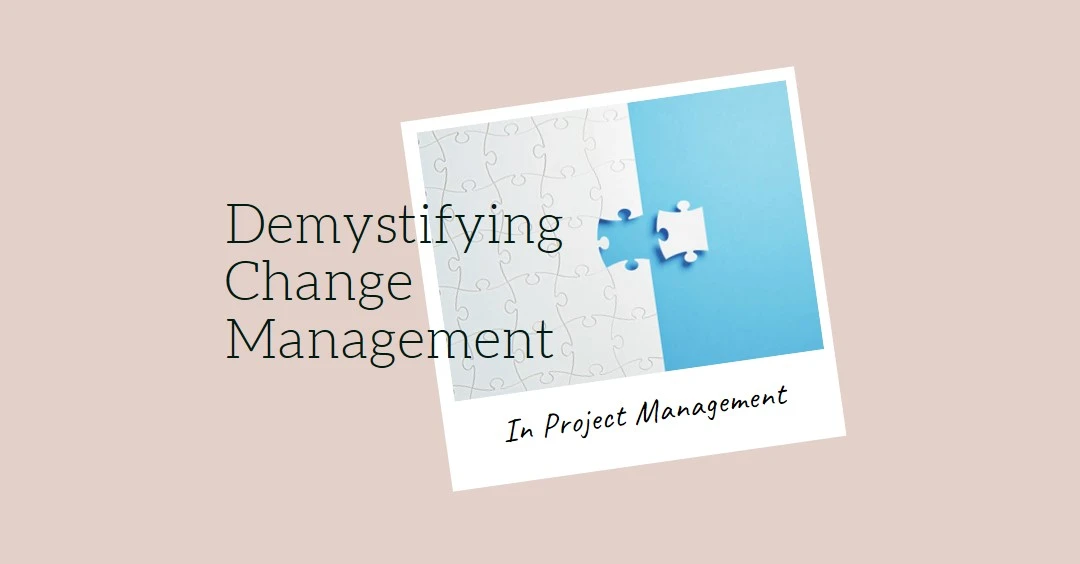I. Introduction
Have you ever embarked on a project, only to find that everything seems to be in a constant state of flux? Changes in scope, shifting deadlines, and evolving stakeholder expectations can make even the most well-planned projects a challenge to manage. If this sounds familiar, then you’ve come to the right place! In this blog post, we’ll be demystifying the concept of change management in the context of project management and explaining why it’s so crucial to ensuring project success.
We all know that change is inevitable, and when it comes to managing projects, it’s not a matter of if change will occur but when. So, how can we stay in control amidst all this uncertainty? The answer lies in understanding and implementing effective change management. By the end of this blog post, you’ll have a better grasp of what change management is, why it’s essential for project management, and how you can integrate it into your projects for more successful outcomes.
But before we dive in, let me share a bit about myself. I’m a seasoned project manager and change management enthusiast, having navigated the ever-changing waters of numerous projects across different industries. My passion is helping fellow project managers and their teams embrace change and thrive in dynamic environments. So, without further ado, let’s begin our journey to unravel the mystery of change management in project management!
II. Defining Change Management
As we embark on our exploration of change management, let’s start by clarifying what it means. At its core, change management is the process of preparing, supporting, and guiding individuals, teams, and organizations through any modifications or transitions that may arise during the life of a project. It’s all about effectively managing change to minimize disruption, reduce resistance, and ensure that everyone involved can adapt and thrive in the new circumstances.
Now, you might be wondering, “What types of changes are we talking about here?” Well, changes can come in various forms, such as:
- Scope changes: These occur when the project’s goals, objectives, or deliverables are adjusted or expanded.
- Budget changes: Budget constraints or adjustments may lead to changes in project resources or timelines.
- Timeline changes: Shifts in deadlines, milestones, or the overall project schedule can have a significant impact on team members and stakeholders.
- Organizational changes: Changes in the organization’s structure or leadership can affect the project’s direction, priorities, or resources.
No matter what type of change you’re facing, the key is to recognize that change management plays a crucial role in project management. It ensures that changes are smoothly integrated into the project, stakeholders’ expectations are managed, and the project stays on track despite any challenges that may arise. In other words, change management is a critical tool for ensuring that your project remains adaptable and resilient in the face of uncertainty.
Having established a clear understanding of change management, we’ll now delve into the change management process itself and explore the steps involved in managing change effectively. So, buckle up and get ready for a deeper dive into the world of change management in project management!
III. The Change Management Process
Now that we’ve laid the groundwork by defining change management and its importance in project management, let’s dive into the change management process itself. Managing change effectively involves a series of steps that, when followed diligently, can help you navigate even the most turbulent project waters. Here’s an overview of the steps involved in the change management process:
- Identifying the need for change: As project managers, we need to keep our eyes and ears open, constantly scanning the project landscape for potential changes. This involves staying in tune with our team, stakeholders, and the broader organizational context. Early detection of change is critical, as it allows us to be proactive and responsive, rather than merely reacting to situations as they arise.
- Analyzing the impact of change: Once a change has been identified, it’s crucial to assess its potential impact on the project. This step involves evaluating how the change will affect the project’s scope, timeline, budget, and resources. It’s also essential to consider the potential risks and opportunities associated with the change, as well as any implications for stakeholder expectations and satisfaction.
- Developing a change management plan: Armed with a thorough understanding of the change’s impact, it’s time to develop a change management plan. This plan should outline the specific steps needed to implement the change, assign responsibilities to team members, and establish clear timelines for each action. It’s also important to include a communication plan that ensures all stakeholders are kept informed throughout the change process.
- Implementing the change: With a solid change management plan in place, it’s time to put it into action. This step involves executing the tasks outlined in the plan, monitoring progress, and addressing any challenges that may arise. It’s essential to be flexible and adaptable during this stage, as unforeseen obstacles or new information may require adjustments to the plan.
- Monitoring and reviewing the change: Finally, it’s crucial to continuously monitor and review the change to ensure that it’s been successfully integrated into the project and that the desired outcomes have been achieved. This step involves gathering feedback from team members and stakeholders, assessing the change’s effectiveness, and identifying any areas for improvement.
Each step in the change management process is vital, as they collectively ensure that changes are managed proactively, effectively, and with minimal disruption to the project. However, it’s important to remember that change management isn’t a one-size-fits-all solution. Different projects and organizations may require unique approaches to change management, so it’s essential to be adaptable and open to learning from experience.
As you continue on your change management journey, you might encounter some challenges along the way. But fear not! In the next section, we’ll explore some best practices for effective change management that can help you overcome these hurdles and emerge victorious.
IV. Best Practices for Effective Change Management
Change management can be a complex and challenging process, but by following some best practices, you can greatly increase your chances of success. As someone who’s been through the ups and downs of change management in various projects, I’d like to share some tried-and-tested strategies that have made a difference for me and my teams:
- Building a strong change management team: A successful change management process starts with the right people. Assemble a dedicated team of individuals with diverse skill sets, expertise, and perspectives. This team should be responsible for guiding the change management process and ensuring that all team members and stakeholders are supported and engaged throughout the journey.
- Communicating effectively with stakeholders: Communication is the lifeblood of change management. Be proactive in keeping stakeholders informed about the change, its impact, and the progress being made. Transparency and open dialogue help build trust, reduce resistance, and foster a collaborative environment where everyone feels heard and supported.
- Establishing a clear change management framework: Having a structured approach to change management can make all the difference. Develop a clear framework that outlines the steps involved in the change management process, roles and responsibilities, and any tools or techniques to be used. This framework should be flexible and adaptable, allowing for adjustments as the project evolves and new information becomes available.
- Training and support for employees: Change can be unsettling, particularly for those directly affected by it. To ease this transition, provide team members with the necessary training, resources, and support to help them adapt to the new circumstances. This may include workshops, coaching, or mentoring, depending on the nature of the change and the needs of your team.
- Continuously reviewing and improving the change management process: Finally, remember that change management is an ongoing process, not a one-time event. Regularly review your change management approach, gather feedback from stakeholders, and identify areas for improvement. By continuously refining your process, you’ll be better equipped to navigate future changes and ensure your projects remain resilient and successful.
By implementing these best practices, you’ll be well on your way to mastering change management and creating a project environment that’s adaptable, flexible, and primed for success. But of course, the journey doesn’t end here. In the next section, we’ll delve into some popular change management tools and techniques that can further enhance your change management efforts.
V. Change Management Tools and Techniques
As we continue to explore the world of change management, it’s essential to familiarize ourselves with some of the tools and techniques that can support our change management efforts. These tools can help streamline the change management process, facilitate collaboration, and provide valuable insights to inform our decision-making. Let’s take a look at some popular change management tools and techniques, along with their advantages and disadvantages:
- Change impact analysis: This technique involves assessing the potential impact of a proposed change on the project’s scope, timeline, budget, and resources. By thoroughly analyzing the consequences of a change, you can make informed decisions about whether to proceed and develop appropriate strategies to mitigate any potential risks.
- Advantages: Provides a structured approach to understanding the implications of a change, helps identify potential risks and opportunities. Disadvantages: Can be time-consuming and may require input from multiple stakeholders.
- Stakeholder analysis and mapping: Identifying and understanding your project’s stakeholders is crucial to effective change management. This tool involves creating a visual representation of your stakeholders, their interests, and their influence on the project. This information can be invaluable in developing targeted communication strategies and addressing stakeholder concerns.
- Advantages: Enhances stakeholder engagement, helps prioritize communication efforts. Disadvantages: May require ongoing updates as stakeholder dynamics change.
- Communication plan: A well-structured communication plan is essential for keeping stakeholders informed and engaged throughout the change management process. This plan should outline the key messages to be communicated, the target audience, communication channels, and frequency of communication.
- Advantages: Ensures stakeholders are well-informed, builds trust and transparency. Disadvantages: Requires regular updates and monitoring to ensure messages are consistent and relevant.
- Project management software: Many project management tools, such as Asana, Trello, or Microsoft Project, include built-in features for managing change. These features can help you track changes, assign tasks, monitor progress, and maintain clear communication with your team and stakeholders.
- Advantages: Streamlines the change management process, enhances collaboration and communication. Disadvantages: May require training and investment in software licenses.
When selecting the appropriate tool or technique for your project, it’s important to consider factors such as the size and complexity of the project, the organization’s culture, and the preferences of your team and stakeholders. Remember, there’s no one-size-fits-all solution, so be open to experimenting with different tools and techniques to find the best fit for your project.
In the next section, we’ll explore some real-life examples of successful change management in project management, providing valuable insights and lessons learned from these experiences.
VI. Real-Life Examples of Successful Change Management in Project Management
To truly appreciate the power of effective change management, let’s take a look at some real-life examples of projects that have successfully navigated change. These case studies highlight the importance of change management in project management and provide valuable lessons that can be applied to your own projects.
- A software development company’s successful product pivot: In this example, a software development company was midway through creating a new mobile app when they received feedback from early users that their original concept wasn’t resonating as expected. Recognizing the need for change, the project manager quickly assembled a change management team and conducted a thorough impact analysis. Based on this analysis, the team decided to pivot the product’s focus, addressing the user feedback while staying within budget and timeline constraints. The result was a successful product launch and a highly satisfied customer base.
- Key lesson: Be responsive to stakeholder feedback and be prepared to adjust your project’s direction when necessary.
- A manufacturing company’s seamless factory relocation: In this case study, a manufacturing company needed to relocate one of its factories to a new location due to new regulations. The project manager initiated a comprehensive change management process, involving extensive stakeholder analysis, communication, and support for employees affected by the move. The company provided ample training, resources, and guidance to help employees adapt to the new environment, and the relocation was completed on time and without any major disruptions.
- Key lesson: Effective communication, stakeholder engagement, and employee support are crucial for successfully managing organizational changes.
- An IT services firm’s smooth acquisition integration: In this example, an IT services company acquired a smaller firm, resulting in a significant change to the organization’s structure and operations. The project manager responsible for overseeing the integration developed a detailed change management plan, involving clear communication with stakeholders, a thorough analysis of the impact on the organization, and a well-defined process for merging the two companies. The result was a seamless integration that minimized disruption, preserved client relationships, and maintained employee satisfaction.
- Key lesson: A structured change management approach, coupled with proactive communication, can help minimize the challenges associated with mergers and acquisitions.
These real-life examples showcase the power of effective change management in project management and the positive impact it can have on project outcomes. As you embark on your own change management journey, remember to draw on the lessons learned from these case studies and apply them to your projects.
In the next and final section, we’ll summarize the key takeaways from this blog post and provide some words of encouragement as you continue your change management endeavors.
VII. Conclusion and Key Takeaways
As we come to the end of our journey through the world of change management in project management, let’s recap some of the key insights we’ve gathered along the way:
- Change management is the process of preparing, supporting, and guiding individuals, teams, and organizations through changes that may arise during a project.
- Effective change management is crucial for ensuring project success, as it helps manage stakeholder expectations, minimize disruption, and maintain project resilience in the face of uncertainty.
- The change management process involves several steps, including identifying the need for change, analyzing its impact, developing a change management plan, implementing the change, and monitoring and reviewing its effectiveness.
- Best practices for effective change management include building a strong change management team, communicating effectively with stakeholders, establishing a clear change management framework, providing training and support for employees, and continuously reviewing and improving the change management process.
- A variety of tools and techniques can support change management efforts, such as change impact analysis, stakeholder analysis and mapping, communication plans, and project management software.
- Real-life examples of successful change management in project management provide valuable lessons and insights that can be applied to your own projects.
Change is inevitable, but by embracing change management principles and strategies, you can transform potential challenges into opportunities for growth and success. As a project manager, you have the power to lead your team and stakeholders through the ever-evolving landscape of projects, creating a positive and adaptable environment that fosters collaboration, innovation, and achievement.
As you continue your change management journey, remember that every project is an opportunity to learn, grow, and refine your approach. Stay open to new ideas, remain flexible, and never stop seeking ways to improve your change management skills. I have no doubt that you’ll become a change management expert in no time, guiding your projects to success despite any obstacles that may come your way.
So go forth, embrace change, and remember that in the dynamic world of project management, change management is your secret weapon for success. Good luck, and happy change managing!
To find out how Artificial Intelligence is changing the Project Management landscape, you have enjoy reading this article https://www.shaunstoltz.com/did-artificial-intelligence-just-change-everything-about-project-management/
Find out more about Shaun Stoltz https://www.shaunstoltz.com/about/
This post was written by an AI and reviewed/edited by a human.



